Before the advent of computer simulation modelling and the Intergovernmental Panel on Climate Change (IPCC), the past record of climate change was assembled from a variety of different types of evidence including chronicles, grain price records, radiocarbon dating, pollen analysis and vegetation history, tree rings, ocean bed deposits as well, of course, as meteorological instrument records.
Before the United Nation’s got involved through the IPCC, the general consensus amongst the geographers, drawing together evidence from these very different disciplines, was that there was a period about 2,000 years ago known as the Roman Climate Optimum, a period of unusually warm, wet, and stable temperatures at least in the Mediterranean. Then it got cold. Welcome to the Dark Ages.
About 1,000 years ago there was another warm period, when harvests were so good and summers so long that communities got together and build grand cathedrals across western Europe. That was known as the Medieval Warm Period. Then it got cold again.
On the third morning of the Alliance for Responsible Citizenship (ARC) conference in London, while I was high in the cable car over the Thames – traversing the river to the conference venue – I imaged the frost fairs that were held during that period after the Medieval Warm Period known as the Little Ice Age.
Paintings and engravings show an elephant being paraded, oxen being roasted, and horse drawn carriages being raced, all across the frozen Thames –beginning in about 1607 and continuing through until at least 1814. This period of some 200 years is thought to corresponds with climate change and there is some evidence it was global.
Indeed, I was recently reading about the excavation of now extinct Adelie penguin colonies in Antarctica with radiocarbon dating showing changes in the geographic range of the colonies beginning about 500 years ago, corresponding with the beginning of the Little Ice Age, more usually associated with freezing Europe.
During the Great Winter of 1683-84 in England, not only did the Thames freeze solid, but also the seas of southern Britain for some few kilometres from shore. Then there is the oil painting by Charles Mozin of the capture of the Dutch warships by the French cavalry when the seas surrounding Holland, suddenly froze solid some 100 years later, in January 1795.
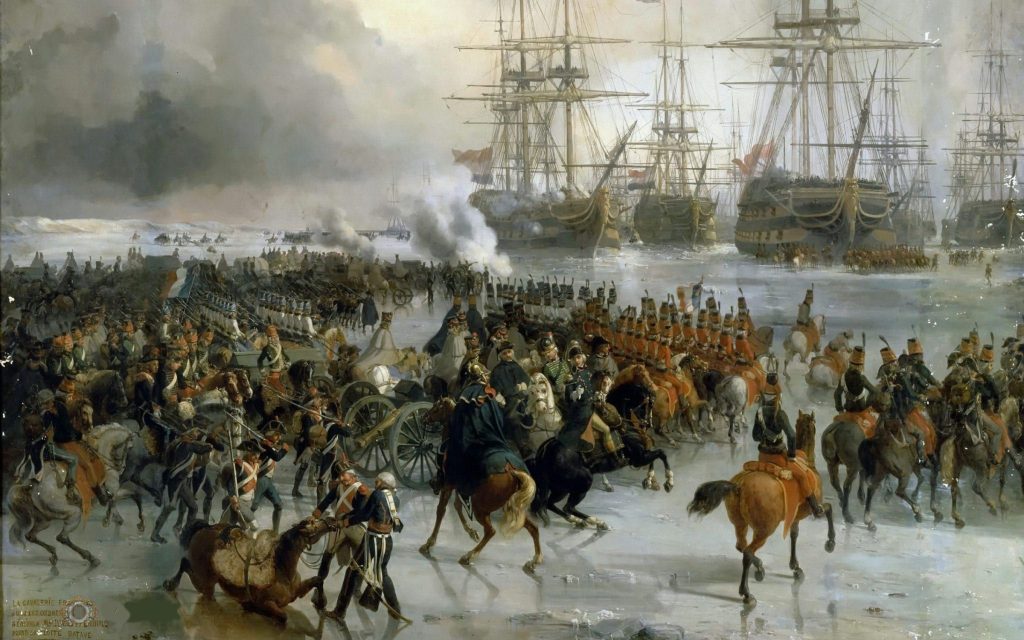
Such is the settled science of climate change, that we don’t really know, what caused this part of the North Sea to freeze over. The story of the frozen armada captured by the French cavalry is not only detailed in the oil painting, but in a wonderful book by Erik Durschmied entitled The Weather Factor along with so many other weather events causing unexpected military defeat.
The IPCC mostly just flattens this entire period of European history, by which I mean the entire temperature record for the 2,000 years before 1800. Perhaps because if this climate change occurred, it was natural and therefore it doesn’t count.
The late 1700s, just before the uptick in global temperatures that is acknowledged by the IPCC, was a time of unusually volatile weather. There was the eruption of the Laki volcano in Iceland in 1783 that lasted for some eight months and then a very severe El Niño in 1791 that lasted for two years. That was when the trade winds stopped blowing across the Pacific and the newly settled colony of Sydney Cove in Australia sweltered. Then just a few years later, in 1795, Europe was plunged into cold again with the freezing over of Den Helder and the defeat of the Dutch armada.
I have a book, Abrupt Climate Change – Inevitable Surprises (US National Research Council in 2002) detailing the early twentieth century warming in Greenland. Specifically, temperature recordings from Danish stations on the west coast of Greenland show an abrupt warming at Upernavik with 4 degrees Celsius rise in air temperature between 1920 and 1930, accounting for all of the warming during the twentieth century – except that the official IPCC reconstructions undo this, turning what was abrupt warming early in the twentieth century into a slow and steady linear increase over the entire century.
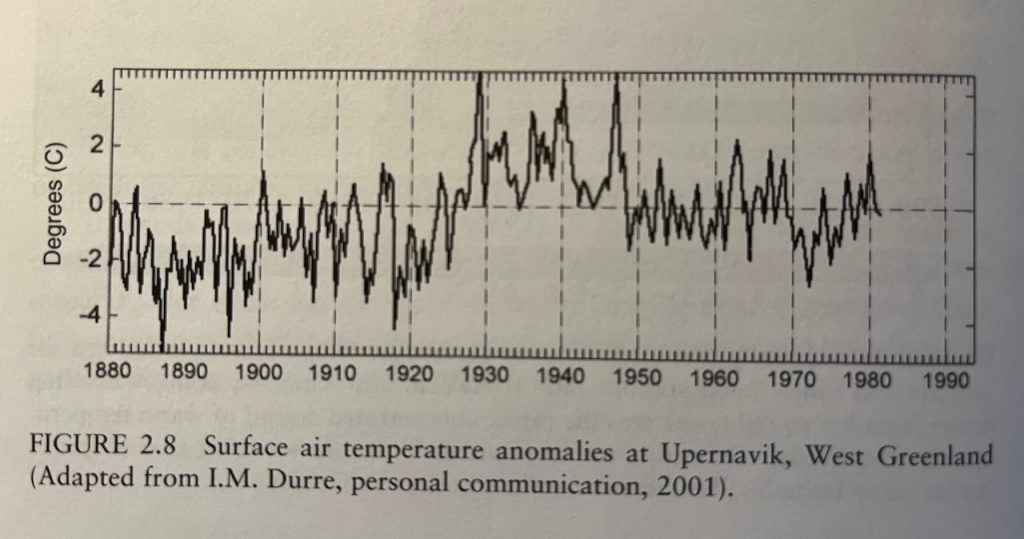
I have long complained about a similar remodelling of the official instrumental temperature record for Australia, whereby the cooling trend so evident in maximum temperature records from at least 1920 to 1960 is changed into continuous warming. On and on, I lament that conservative politicians have had opportunity after opportunity to do something about this, but refuse, always finding some excuse.
Then I travelled to London for this ARC conference and I found so many of these past and present conservative Australian politicians being encouraged not only to believe that climate change is human-caused, but something that is essentially slow and steady in nature – not just in Australia, but globally. I now despair that they will ever do anything about restoring integrity into the historical temperature record – for anywhere, at any time.
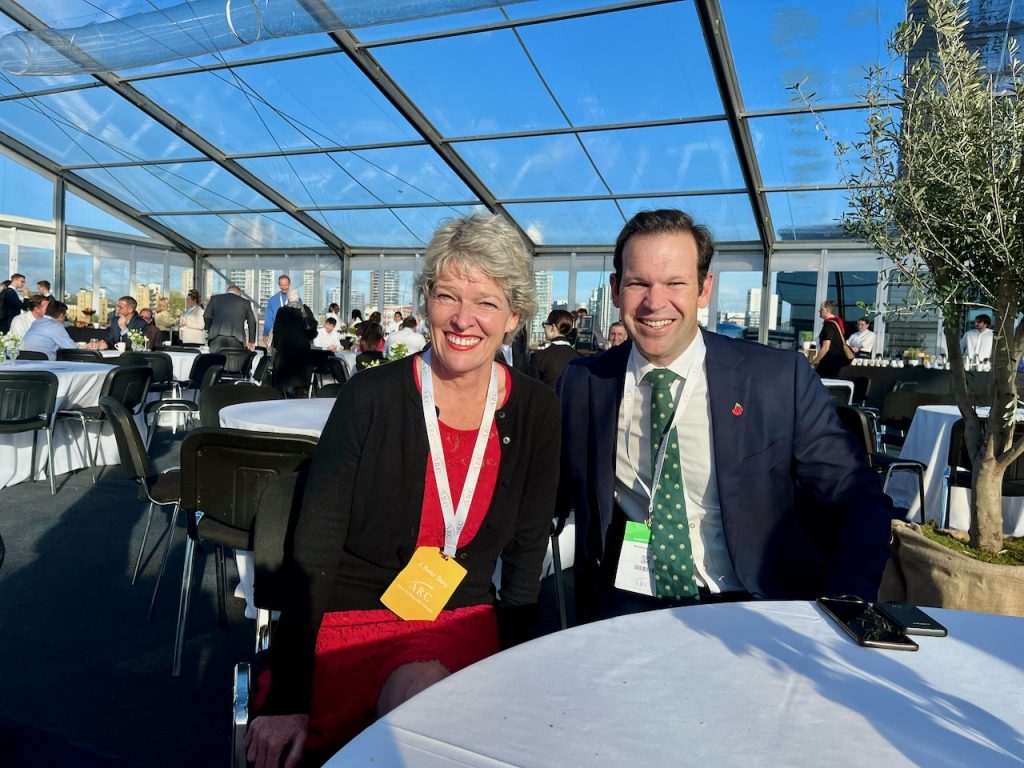
This ARC conference, which conservatives from across the West are rejoicing about, and that was unashamedly about finding a better story, is telling a climate story that bears absolutely no relationship to the truth. And there is no real opportunity for dissent, not at that event, and not since within these same political networks.
A key message in the interview with physicist Steve Koonin on the afternoon of the second day is that there has been a slow and steady increase in global temperatures of exactly 1.3 degrees Celsius over the last 100 or so years. Nonsense. The more credible story, and as detailed in the book entitled Ice Ages, by John and Katherine Imbrie (published by Harvard University Press, 1979), is that there was thirty years of global cooling to about 1960 with the amassed technical literature thus forecasting a coming ice age at that time.
Complementing the nonsense idea of slow and steady warming from Koonin, Alex Epstein made the comment at the Energy and Environment dinner on the evening of the second day that Antarctica was melting albeit slowly. Never mind that even the IPCC reports acknowledge that Antarctica is likely to be gaining mass with the global warming as simulated by the IPCC computer models resulting in more snowfall. To be clear, Antarctica has made no, that is correct zilch, contribution to their official estimates of sea level rise through the twentieth century. That is, of course, before the recent significant reduction in sea ice beginning in 2016, which suggests a marked change in trend.
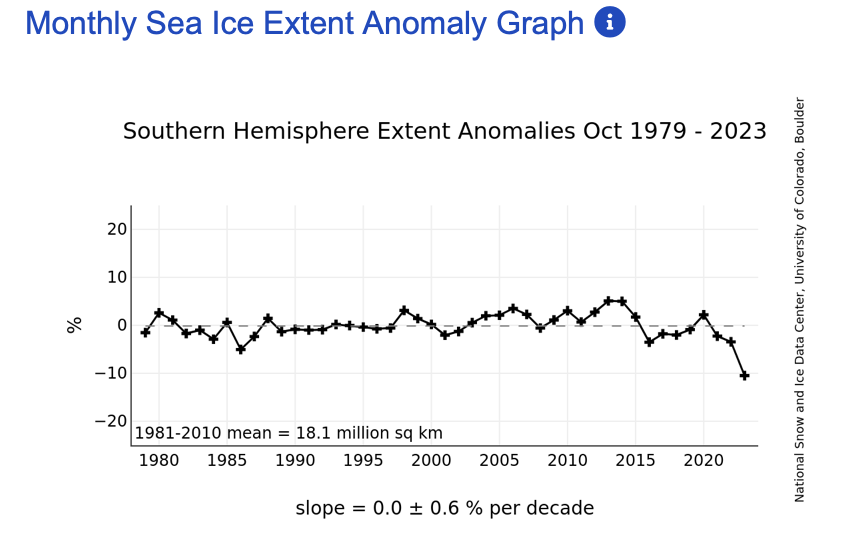
It is not as though the organisers of this conference, foremost amongst them former Australian Deputy Prime Minister, John Anderson, do not know better.
John Anderson is part of a network that has been repeatedly shown the extent of the remodelling of the official temperature records, and the impossible IPCC physics most recently in the form of a series of IPA sponsored lectures by Will Happer from Princeton University. And John Anderson has witnessed the devastating flooding along much of the east coast of Australia despite the IPCC forecasts that the new climate for Australia would be one of endless drought.
Continually on and off the stage across the three days of the ARC conference, John Anderson might have mentioned the spiking that is now occurring in the UAH satellite record of global temperatures – normally the go-to for conservatives interested in climate change. He never mentioned climate change, or covid-19 lockdowns or how his government rushed Australian troops into Iraq, or how, when he was deputy Prime Minister, the beginning of the destruction of the reliability of our energy network was instigated with the Renewable Energy (Electricity) Act 2000. More about this in an important new report launched on the sidelines of ARC by the IPA with Stephen Wilson. (I was going to make part 3 in this series about energy, but it can wait.)
As surely as the Earth rotates eastward, spinning on its axis creating night and day, the deceit out of ARC risks to hasten the downfall of Western civilisation; through the hubris and denial until we are so stuck in ice we are easily destroyed. Yet Western civilisation was the one thing that ARC claimed it was all about saving. Except that for redemption there must first be some acknowledgement of the mess that Anderson and his colleagues have created over the past few decades.
One of the few presentations that explained this core issue of the need for redemption was by theologian Amy Orr-Ewing. She asked that we acknowledge past injustices. Her presentation opened the second day. I cannot find it on the official ARC YouTube channel, perhaps because it was tangential to the official line, but it is available at ADH TV, click here.
While Jordon Peterson advocated the need for individual responsibility as the way to find meaning in life, Amy Orr-Ewing suggested that there was first a need for institutions to acknowledge past injustice and suffering. She also had much to say about the power of redemption and forgiveness for individuals and also communities, and even the South African nation. This would seem incredibly relevant given how much we now know, including about the abuse of children in church run schools across the Western world. (When I looked at the report that came out of the Royal Commission some years ago the most abused cohort by number were white boys born in 1963, my year.)
But I diverge.
On the energy and environment theme, there was also Michael Schellenberger, insisting that we must do away with pesky sceptics at that dinner as I explained in part 2 of this series, and on the Monday afternoon of the conference he claimed that the slow and steady increase in sea levels of about 25 centimetres since 1880 was not something to be too concerned about. Schellenberger was a darling for so many, not only at the conference, but last time I looked his presentation was one of the most popular at the ARC YouTube channel. (The lies they spread.)
In reality there has been nothing slow and steady about sea level rise, not even for the small Pacific Island nation of Tuvalu.
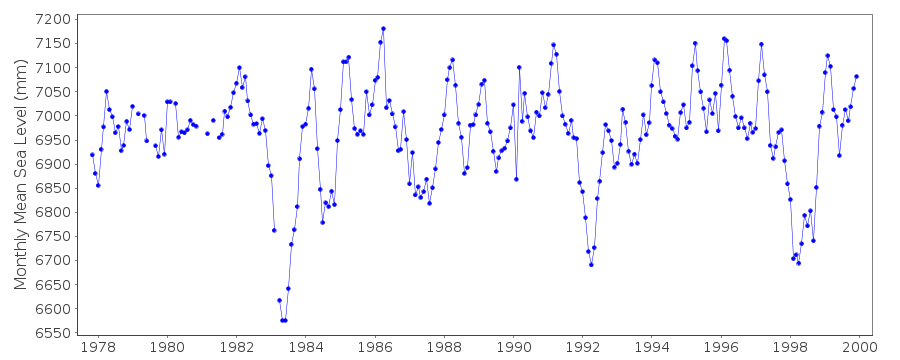
The media headlines scream rising sea levels. But the most obvious pattern in the first twenty years of official sea level data for Funafuti, the capital of Tuvalu, are three periods of abrupt sea level fall corresponding with the significant El Niño of 1983, the weaker El Niño of 1992, and then the very strong El Niño of 1998.
We only have reliable sea level data for Tuvalu beginning with the satellite record in 1979, and the first recorded very significant drop in sea levels at Tuvalu was in 1983 because of the collapse of the trade winds associated with that massive El Niño event.
El Niños are most obvious as the sloshing of great amounts of warm water from the western Pacific toward the Americas, followed by the shutting down of ocean currents along the west coast of South and Central America.
In the book El Niño, History and Crisis (edited by Richard Grove and John Chappell, The White Horse Press, 2000), there is a table of archive-based El Niño series for the past 500 years. They manifest when the trade winds stop blowing across the Pacific Ocean, then there is no upwelling of nutrient rich waters along the Peruvian coast, often with dire consequences for the local fishery, and also for global temperatures.
When the trade winds stop blowing, warm water will begin to pool across the equatorial Pacific and this water will start to move east, which is the direction in which the Earth rotates.
The most recent El Niño began in April just this year, and there is now a very large pool of quite warm water straddling the equatorial Pacific.
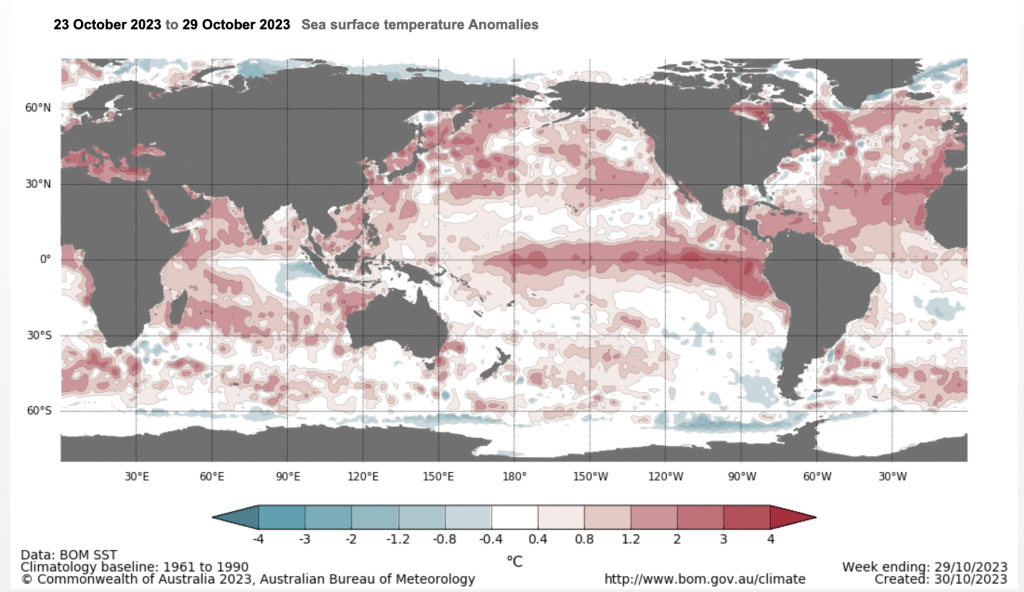
The Earth rotates eastward, spinning on its axis creating night and day. Then there are the seasons because as the Earth makes one revolution around the Sun in each 365-day period, its axis is tilted – with the southern hemisphere tilted towards the Sun as we approach summer here in Australia. And it is likely to be a scorcher, not because there is more carbon dioxide in the atmosphere, but because the trade winds stopped blowing across the Pacific Ocean earlier this year, with the spiking in the satellite temperature record a manifestation of this.
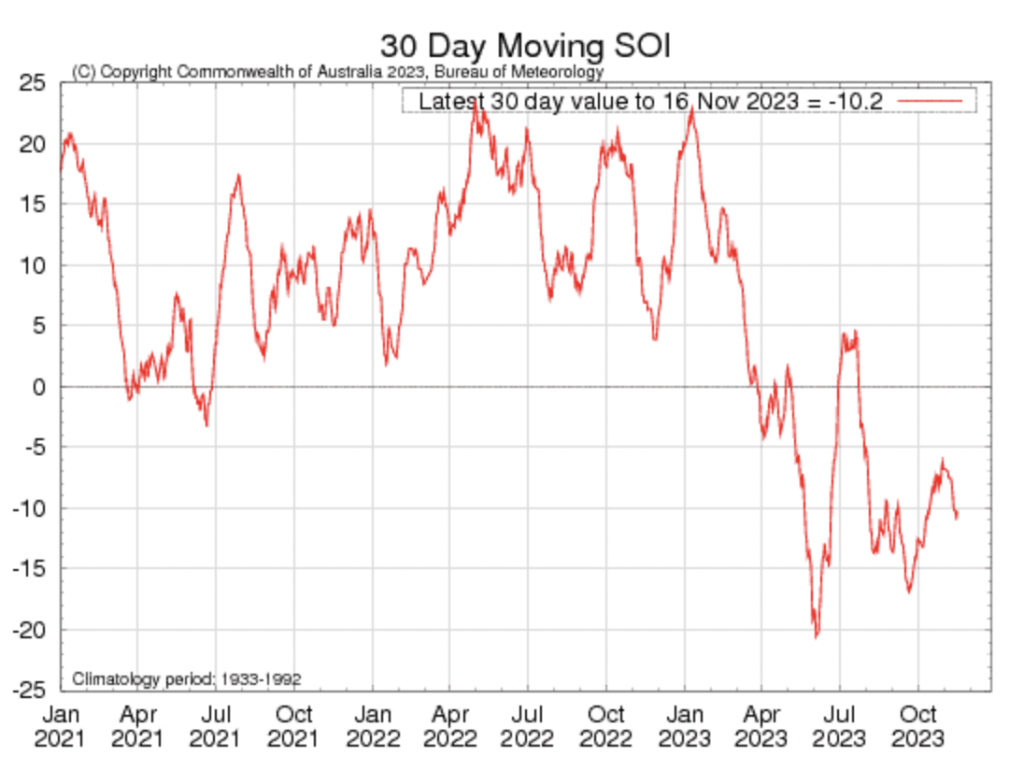
The Southern Oscillation Index, measured as the difference in air pressure between Tahiti and Darwin remains negative. And the warm waters spreading across the Pacific are becoming even warmer. The Nino 3.4 sea surface temperature index already exceeds 1.5 degrees Celsius. In fact, it has climbed from minus 0.5 degrees to plus 1.5 degrees just this year.

This warmth is spreading through the Earth’s atmosphere, as clouds are formed and also thunderstorms move the heat upwards, and the winds then blows it poleward.
This is manifesting as a growing spike in the satellite measures of global troposphere temperatures. According to the UAH Satellite temperature record, the world is the hottest it has ever been – or at least since the beginning of the satellite record in 1979.

There is no known physical mechanism whereby carbon dioxide can cause an El Niño. Climate change is a natural hazard.
This warming that reliably began in the central, equatorial Pacific Ocean when the trade winds stopped blowing in April, is caused by lunar tidal gravitational forcing. I am referring to the cyclical changes in the orbit of the moon about the Earth that follows an 18.6-year cycle and not always regular in magnitude because the strength of the forcing will change depending on its alignment relative to the Sun, and because the forcing reverses from a maximum to a minimum declination every 9 years, in the same way that the tilt of the Earth reaches a maximum of 23.45° on June 22 (summer solstice in the northern hemisphere) crossing over to a minimum of -23.45° on December 21-22.
There are cycles within cycles, and by their very nature they can appear to keep reversing and they do affect the climate. If we took notice of them, we might be able to forecast when the Thames is likely to next ice over.
To be continued.
*****
ADDITIONAL INFORMATION/NOTES
The painting of the Dutch warships stuck in ice is on public display at the Chateau de Versaille, more information here.
In the photograph of me in red, I am with Australian Senator Matt Canavan.
The question of whether Antarctica is ‘melting’ or not, is both important and complex. According to Climate Change 2001, The Scientific Basis (page 665) and most treatments since by the IPCC, Antarctica is overall gaining in mass.


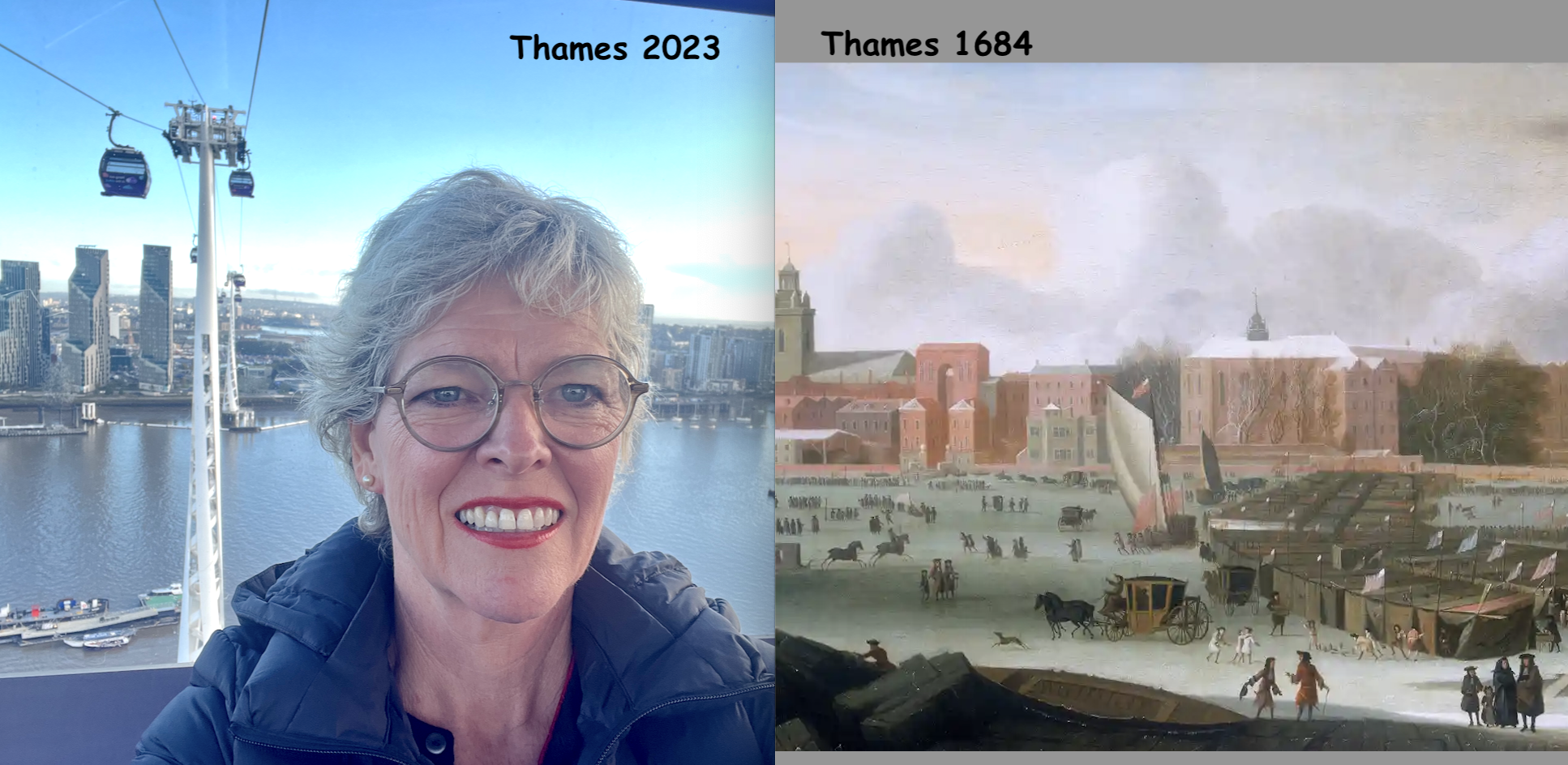
 Jennifer Marohasy BSc PhD is a critical thinker with expertise in the scientific method.
Jennifer Marohasy BSc PhD is a critical thinker with expertise in the scientific method.

Sea level rise would increase the inertia of the crust of the earth that spins at a different rate than the core of the earth. That would make Length of Day increase.
Time has been measured with the Atomic Clocks since 1972, less leap seconds have been added every decade and the last leap second was added in 2016.
This does mean that sea level is lower than in 1972 and not currently going up.
http://www.nist.gov/pml/div688/grp50/leapsecond.cfm
Your article is well done and described Jennifer. Unfortunately we have disparate views from so-called conservatives that prattle on around the periphery. There is so much to unpack from these talks as well as the lukewarm inputs from like GWPF etc
Reality is what it is not models or prognostic imaginings.
Why only show Greenland temperatures up to 1982? Do the temperatures after that not fit with your fossil-fueled narrative?
https://www.nature.com/articles/s41586-022-05517-z
Global Warming is economic reform. It’s quite predatory. We all pay for it. That’s why the conservative politicians run with the hare and chase with hounds, why billionaires fund Teals, why the MSM doesn’t criticality scrutinise it and the banks are uncharacteristically altruistic about it.
We can’t do much about it because our votes are corralled. All the activity may not necessarily be a bad thing except the subsidies could probably be better spent
After seeing the sea levels at Tuvalu, I had to look at Boston, nearest NOAA gauge in New England. The same El Nino events are not evident, but what is evident is no change in sea level.
https://tidesandcurrents.noaa.gov/waterlevels.html?id=8443970&units=standard&bdate=19780120&edate=20010101&timezone=GMT&datum=MSL&interval=m&action=
https://ifunny.co/picture/plymouthrock-1620-atsealevel-plymouth-rock-2022-still-at-sea-level-EsfoNvCk9
This explains all of it, so succinct that any idiot could understand.
Many thanks Jennifer for pursuing the fight. I understand the ACR conservatives hesitance in fighting the climate change myth. Their focus was on the collapse of western civilisation through abandonment of our social values and education. These things will destroy us before any dodgy climate change.
Better colours on this map, maybe not been ‘got at’? That cold water at the South of the Humboldt is getting bigger and colder, to my casual eye. We may perhaps be in more neutral territory, for a couple of years yet. A lot of volcanic activity happening though.
I have a long range summary which shows a bad drought in 2025.
https://www.ospo.noaa.gov/Products/ocean/sst/anomaly/
Brian Sanderson, why did you not use the full dataset for Boston? Because it’s doesn’t fit YOUR narrative?
https://tidesandcurrents.noaa.gov/waterlevels.html?id=8443970&units=standard&bdate=19780121&edate=20220102&timezone=GMT&datum=MSL&interval=m&action=
This is the data set that I usually use, https://psmsl.org/data/obtaining/stations/235.php , and provided here for Boston.
It suggests about a 50 cm rise, more than double what the IPCC/Schellenberger are claiming. It depends where you measure it, a bit.
Heat comes from the Sun, not the Moon.
It is transferred to the Planet, via the Atmosphere.
Get El Nino out of your head Jennifer….
There are ALWAYS 360 Day/Night Intervals in One Earth/Solar Orbit. (360 Degrees)
https://drive.google.com/file/d/1TFFDXyhe5b0ZfLCiFt23W4PbubQaQfQo/view?usp=sharing
About current volcanic activity. The Kamchatka one alone is massive. And not far from HAARP either?
https://endoftheamericandream.com/are-you-prepared-for-the-cataclysmic-earth-changes-that-are-on-the-way/
Don, the Sun can not heat the atmosphere, not directly. it can heat the oceans, directly.
How many journalists who focus on “climate change” ignore the significant pollution created by the same companies who profit from the wind turbines and solar panels or the financial insecurity that these technologies bring.
How many highlight the resources being extracted for them or those who must suffer to bring them from the earth. . Janelle Ellis, who is doing her PhD in Africa studying the social conditions in the mines, told me that they use the poor immigrants for labor because when they die they do not have to answer to anyone and in the Congo child labor is appalling. https://www.facebook.com/elle.ellis.research.
Perhaps you could attend the Indaba conference in 2024 https://miningindaba.com/agendas/2024-agenda and report back about the cost in human lives from the demands for the technology to “change the climate”. . Janelle could link you to those who do care. You can mention my name .
I could not dispute your data, but the speakers at ARC I have watched have acknowledged that the climate always will change but they spoke about a bigger picture, a compelling need for greater consciousness of the spiritual and moral purpose for life because the poorer we become in spirit and financial insecurity the less we will care about Gaia.
You may have been disappointed ARC was not more focused on the issues of climate change and may not like John Anderson but at least his podcasts are about being better informed about world wide issues . Do you have a better way? Do you have a better story?
So true Jennifer: the capitulation by the conservatives about AGW is the real problem. The best they can come up with is that AGW is real but nothing to worry about. Or that China is much worse. The idea that AGW is grotesque and wrong never seems to inform them.
With school kiddies protesting, idiots undergoing hunger strikes and religious leaders claiming the Pacific islands are drowning I must say I’m a bit pessimistic about getting the message across; I spend some time commenting on talkback and questioning AGW gets short shrift. Maybe the penny will drop when the power black outs start happening.
Thanks again Jen, for some good observations.
The most convincing proof of non-existent AGW, I feel, is the big tree stumps under those glaciers, which would have required temperatures 1 to 2 thousand years ago of up to possibly 20c warmer than currently, to occur.
Pity they don’t point out the obvious to the kiddies.
Nothing unprecedented.
Comment on Bep. Boston data is feet +/- from zero. In 100+ years mean tide appears to go up from -6inches to +2inches. Is there any eustatic rebounding still happening from the two plus kilometres of ice that sat over that chunk of land less than 16000 years ago?
Because in this Blog, the dates for sea kevel conversation were 1978 – 2000. I don’t have a narrative.
Thanks Elizabeth. If ARC hasn’t sorted out their climate change story, as you suggest, then they should have left the ‘energy and environment’ theme off the program.
They have sorted their climate change story, and it is a lie.
Cheers,
Absolutely brilliant!! Both the writing and the plainly and beautifully explained science.
Thank you Jennifer for sharing your wisdom. I look forward to reading much more of your work.
Thanks for the solid reporting on the ARC gabfest. Glad you had a chat with Matt Canavan he is one of my heros, and knows his stuff on climate. However, as an ambitious conservative frontman he has to watch himself with his more timid National and liberal colleagues.
It is very troubling that since Abbott was rolled by Turncoat that the truth behind climate science has not been exposed to debate and the complicit CSIRO and BoM have not had their due comeuppance. Keep up the good work. I will do my best with the publication of my eBook `Climate Science – A Sceptical Review’ due out next week through Amazon.
Cheers,
Much thanks to Charles/Anthony for reposting, https://wattsupwiththat.com/2023/11/19/political-and-natural-hazards-arc-part-3/
And it is always good when Ulric Lyons, and others, add some.
And just filing this here:
“You mention the winter 1683-84.
A few years earlier Sweden was, as usual, at war against Denmark, and as usual we [Denmark] lost.
The Swedish king Karl 10th Gustav led an army of 7000 men, including cavalry and cannons over the ice covered Little Belt, where I sail in my sailboat.
The current is strong, it takes very low temperatures to form ice, and
then even solid ice.
His army then crossed The Great Belt and he tried to take Copenhagen, where he finally was stopped. The armistice cost us all land in Sweden, land that had been Danish for 500 years, leaving the lop-sided Denmark with its capital on the eastern fringe.
Sweden waged horrendous ethnic cleaning it the entire southern part,
and they stole most that wasn’t bolted in place.
Later we lost the provinces Schleswig/Holstein which had been Danish for 600
years. The second-largest Danish city was Altona, now in central
Hamburg, again due to stupid Danish politicians and the war-monger
Bismark. We got the northern part of Schleswig back in 1920 after a
referendum, a model they should copy in Ukraine. [end.]
Jennifer
You might find this interesting. Your not-knowing-much-about-the-GBR, ‘friend’, FrendlyJordies :
https://www.theguardian.com/australia-news/2023/nov/22/youtuber-friendlyjordies-house-fire-sydney-nsw-arson-attempt-police-appeal